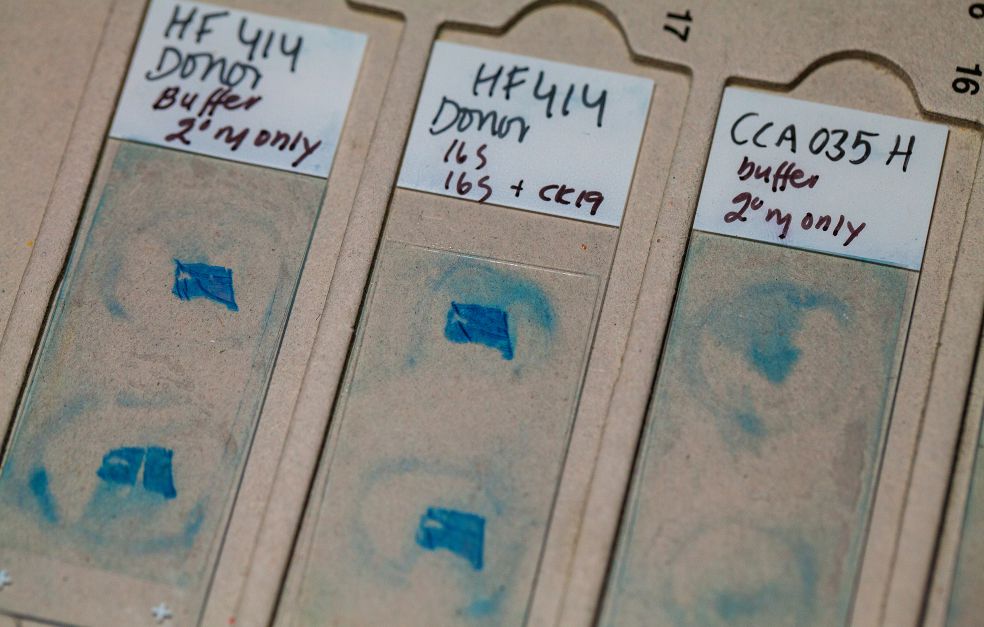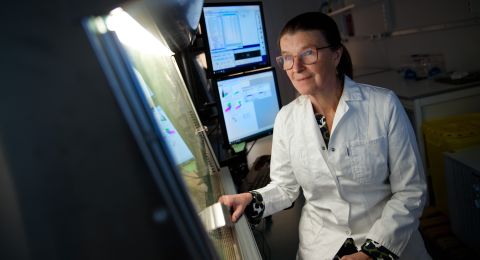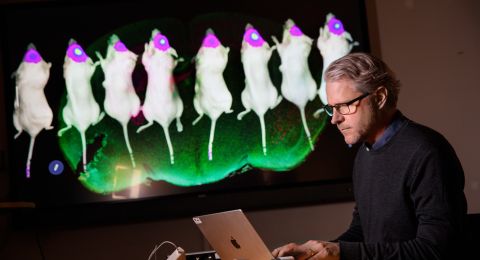NK cells – natural killer cells –plays a central role in the immune system by targeting and killing virus-infected cells as well as cancer cells. However, the might also contribute to disease. Niklas Björkström is studying NK cells in healthy livers, and the part they play in various liver diseases. These studies can be used to develop better treatment of liver diseases such as liver cancer, fatty liver disease, and cirrhosis of the liver.
Niklas Björkström
Associate Professor of Immunology
Wallenberg Academy Fellow 2016
Institution:
Karolinska Institutet
Research field:
The liver’s natural killer cells and the part they play in various kinds of liver disease in humans.
“It’s highly unlikely that I will cure cancer but contributing a piece of the puzzle is the aim of what we’re doing here,” says Björkström, casting his eyes over the laboratory facilities at Karolinska University Hospital in Huddinge, south of Stockholm.
Björkström is a clinical researcher, a doctor conducting research. He heads a research team at the Center for Infectious Medicine at Karolinska Institutet, but also does clinical work as a resident physician in clinical microbiology at Karolinska University Hospital.
Although he is conducting basic research, the close proximity to patients at the hospital is of critical importance.
“Karolinska University Hospital in Huddinge specializes in liver disease. It is essential to be close to the clinics and have ready access to samples from patients, such as biopsies. There is also a great deal of expertise and interest among hepatologists, surgeons and other clinics in the field. That’s why we and other research teams from Karolinska Institutet are based here.”
Permanent residents
As a Wallenberg Academy Fellow, Björkström is studying how tissue-resident NK cells in the liver develop, how they are regulated, and the nature of their function when they work as they should, defending the body against virus attacks and cancer cells, but also when something goes wrong and they are a contributory factor in disease.
NK cells are a type of lymphocyte, white blood cells belonging to the immune system. Our knowledge about NK cells is fairly new, and stems from research at Karolinska Institutet. NK cells were discovered in the mid-1970s by Rolf Kiessling, Eva Klein and Hans Wigzell.
It was long believed that NK cells recirculated by entering tissue and then rejoining the bloodstream. But in recent years researchers have concluded that this is not really the case.
“Most NK cells seem to be permanent residents of various organs, although some do circulate. And it differs from one organ to another, depending on the organs’ different functions and conditions."
“The grant allows me to think big and adopt a long-term approach – it gives me the confidence to start major projects and consider new angles."
Reacting to stress
The liver detoxifies all blood from the intestine before it enters the bloodstream. This also creates specific conditions for operation of the immune system.
Hepatocytes are the commonest liver cells. In an article in Nature in 2017 researchers were able to show that there are nine sorts of hepatocyte, each performing different tasks, depending on their position in the detoxification chain from when blood enters until it leaves the liver.
“There is probably a similar pattern to where certain types of immune cells, such as NK cells, must be situated in order to perform a given function, but it’s hard to study. We’re using advanced microscopy to try to distinguish the different NK cells, to see where they are located, what specialties they have, and whether they kill different kinds of cells. But we also want to understand how they work when various liver diseases develop. Are they a factor in onset or progress of the disease, or do they offer protection?”
He explains that NK cells react to various kinds of cellular stress. These include virus infections, cells that mutate into cancer cells or mechanical stress, as in metabolic diseases like high blood pressure, diabetes and obesity.
“Stressed cells signal this via proteins on their surface. NK cells detect those signals and kill the cells. This is fine if the cells in question are cancer or virus-infected cells, but experiments using mice models have indicated that by reacting to stress from hepatocytes that store fat, NK cells can also trigger an inflammation in the liver that may lead to cirrhosis, and ultimately liver cancer. We want to understand the process and see whether it is the same in humans.”
Preventing cirrhosis of the liver and cancer
The most common liver disorder is called NAFLD (non-alcoholic fatty liver disease), and its extreme form NASH (non-alcoholic steatohepatitis). These conditions are linked to the metabolic syndrome. Some 30–35 percent of all Americans, and 15–20 percent of all Swedes are estimated to have developed fatty liver, largely due to overweight.
“In itself, it’s not a huge problem, but some of those people develop inflammation of the liver in the form of NASH, which in turn can lead to cirrhosis and liver cancer. This is the commonest reason for liver transplants nowadays, since the disease is untreatable.”
It takes time to develop cirrhosis of the liver (20–30 years), and it can be avoided by radical weight reduction. But most people are not able to lose the amount of weight required.
Björkström believes that one way of treating fatty liver disease may be to block the NK cell to prevent it from responding to stress from the liver cells that store fat.
“The problem is finding the right signals to block. But there are other ways of trying to neutralize the response.”
Another part of Björkström’s research involves studying the bile ducts in the liver.
“Most people think of the liver as a single organ, but it’s really two co-existing systems. The biliary tract, or tree, joins up to form the common bile duct leading to the duodenum. We want to develop methods that will enable us to study the biliary tract, which has not been researched at all from an immunological viewpoint. We want to identify the immune cells that are resident there. To some extent we are trying to understand a new area of biology.”
Many diseases of the bile duct are untreatable. The aim of this research is to find out how these diseases develop, knowledge that may lead to therapies in the future.
Text Carina Dahlberg
Translation Maxwell Arding
Photo Magnus Bergström





